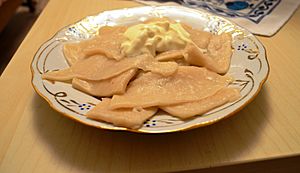Lazanki facts for kids
Lazanki (pronounced lah-ZAHN-kee) is a special type of pasta popular in countries like Belarus, Lithuania, and Poland. It's made from simple ingredients like wheat, rye, or buckwheat flour. This flour is mixed into a dough, which is then rolled out very thin. After rolling, the dough is cut into small triangles or rectangles.
Once shaped, these pasta pieces are boiled until they are soft. Then, the water is drained away. Lazanki is often eaten with melted pork fat or vegetable oil. Sometimes, people add sour cream for extra flavor. In Poland, it's very common to mix lazanki with fried cabbage or soured cabbage. Small pieces of sausage, meat, or mushrooms are also often added to make a hearty meal.
The Story of Lazanki
How Lazanki Came to Europe
Lazanki arrived in the Polish–Lithuanian Commonwealth in the mid-1500s. This was a very large and powerful country back then. The person who brought this pasta was Bona Sforza. She was an Italian princess who became the wife of King Sigismund I the Old.
Italian Roots of Lazanki
Bona Sforza loved Italian food. She introduced many delicious Italian dishes to her new home. Lazanki reminds us of the Italian pasta called lasagne. Lasagne are large, flat sheets of pasta. Lazanki are like tiny versions of lasagne. Their names in Polish and Belarusian even sound like "little lasagne."
Lazanki Today
Many Italian dishes that came to Eastern Europe long ago are not eaten much anymore. But lazanki is different! It has stayed popular for centuries, even into the 21st century. It's a dish that connects people to a long and interesting food history.


